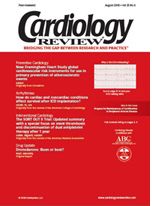Early statin therapy in ACS: Reducing the burden
There is increasing evidence that in the setting of an acute coronary syndrome (ACS), early therapy with HMG-CoA reductase inhibitors (statins) may be beneficial. Trials such as the Scandinavian Simvastatin Survival Study (4S), the Long-term Intervention with Pravastatin in Ischaemic Disease (LIPID), and the Cholesterol and Recurrent Events (CARE) trial helped to establish the role of statins as essential therapeutic agents in the secondary prevention of cardiovascular disease (independent of baseline cholesterol levels).1-3 The Myocardial Ischemia Reduction with Aggressive Cholesterol Lowering (MIRACL) trial examined treatment in the period immediately after an ACS and showed that early statin therapy reduced the recurrence of symptomatic myocardial ischemia.4 Subset analysis showed that early statin therapy reduced the circulating levels of C-reactive protein (CRP) and serum amyloid A.
CRP has been shown to have numerous proinflammatory properties and so reduction in CRP was postulated to not only be a marker of reduced inflammation but rather evidence that statins may serve to attenuate potential direct inflammatory triggers.5,6 Other studies have shown that early statin therapy not only resulted in event-free survival benefits but also increased minimal luminal diameter as seen in quantitative angiography.7
In this study, Okazaki and colleagues (page 29) aim to show that early statin therapy after ACS would induce a significant reduction in plaque volume in nonpercutaneous coronary intervention (non-PCI) sites. They postulate that the anti-inflammatory properties of statins reduce plaque volume, increase luminal diameters of coronaries, and therefore may confer protection from recurrence of cardiovascular events. In this prospective, open-label, randomized, single-center study, the investigators randomly assigned 70 patients to either atorvastatin (Lipitor) 20 mg orally once daily or a lipid-lowering diet (a cholesterol absorption inhibitor was added to the control group if low-density lipoprotein [LDL] cholesterol was greater than 150 mg/dL after initiation of the diet) 24 hours after PCI and intravascular ultrasound (IVUS) measurements were completed for ACS. The target segment for these IVUS measurements was determined in a non-PCI site, and vessels with marked tortuosity or calcifications were excluded. An inves-tigator blinded to patient group and angiographic results performed quantitative analysis. At the completion
of the study, 48 patients (24 in each group) were analyzed (most patients were excluded due to marked tor-
tuosity or calcifications in the target vessels). At the 6-month follow-up
the results showed that the plaque volume was reduced significantly (13.1 ± 12.8%) in the atorvastatin group and increased in the control group (8.7 ± 14.9%) with the difference reaching statistical significance (P < .001). They also showed that the reduction in plaque volume had a significant positive correlation with follow-up reduction in LDL levels. Major adverse coronary events did not differ between the two groups.
While the authors acknowledge that their study is limited by a small sample size, they do not address that the study lost over a third of its participants before analysis. It is unclear whether the final 48 subjects were matched at baseline. Furthermore, the selection of the target vessel for serial measurements was nonstandardized and left to the discretion of the nonblinded operator during the PCI. Despite its limitations, the study does highlight the importance of early statin therapy after ACS.
Questions left to be answered include the following: Independent of LDL levels, what does the reduction of plaque volume mean in terms of clinical significance? Are the reduced plaques in fact more stable, and (again independent of LDL levels) do they confer protection to the patient? Nonetheless, these findings imply that patients with ACS are in a unique position to have the burden of their disease ameliorated through statin therapy. It remains unclear if early statin therapy alleviates impaired endothelial activity, reduces overall inflammation, or acts through an antithrombotic pathway, but clearly this treatment is beneficial and should be considered early in all patients with ACS.
